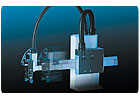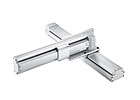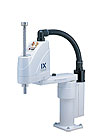
It’s the simplest operation in automated assembly: Pick up a part at one location and place it in another. No tools are involved. There’s no torque to measure or force to monitor.
And yet, engineers have several options to get the job done. Engineers can choose cam-driven, pneumatic or electromechanical pick-and-place units. They can order a preconfigured off-the-shelf system, or build one themselves from standard linear and rotary actuators. Alternatively, engineers can opt for the ultimate pick-and-place device: a Cartesian, SCARA or delta-style robot.
Which way to go depends on the application. What is being assembled? How large are the parts? How much do they weigh? How will they be presented for pickup? How far will they be moved? How accurately do they need to be placed? Will the part simply be put in place, or does it need to be pushed onto or into another part? How big is the work envelope? What are the production volume and cycle time requirements? How flexible does the system need to be? What are the cost, time and manpower constraints?
Creating a custom pick-and-place unit will ensure engineers get exactly what they need. That could save money, but it also takes time and engineering skill. A preconfigured system will be up and running sooner.
Cam-driven systems are ideal for high-volume assembly and long-term production runs. They are best for retrieving small, singulated parts from fixed locations and carrying them short distances. At the opposite end of the spectrum is the SCARA robot. Its strengths are flexibility and a long reach. Design changes and high-mix production are no problem-just reprogram the machine.
“SCARAs are great because they provide an extra axis of motion. You get X, Y, Z and u [rotation around the Z axis],” says Chris Prior, senior engineer atIAI America Inc. “If you add machine vision, you can grab a part in a random orientation and in the process of moving it to the pallet, you can get it into the right orientation.”

This pick-and-place unit combines both pneumatic and cam technologies. A pair of pneumatic cylinders provide both the horizontal and vertical motion, but their motions overlap and are positively driven by a curved roller. Photo courtesy SCHUNK Inc.
Air Power
Pneumatic and cam-driven systems are the least expensive options for pick-and-place operations.Because they are powered by air cylinders, pneumatic pick-and-place devices can be built in a variety of configurations. Modular, off-the-shelf components can be assembled like an Erector Set to produce virtually any combination of linear and rotary motion.
For example, one cylinder can be used for the horizontal axis and one for the vertical axis. A pneumatic rotary actuator can be added to the end of the vertical axis to tilt, flip or rotate the part.
Or, one cylinder can be used for the vertical axis. Then, one end of a beam can be attached to a rotary actuator on top of the vertical axis, while the other end carries a gripper. Now, instead of moving parts up, across and down, the actuator can transfer parts from one location to another with a swinging motion.
In another variation, the beam can be attached to the rotary actuator at its midpoint. With grippers at either end of the beam, the unit can pick and place two parts at the same time.
Modular pneumatic components for pick-and-place applications are available from many suppliers, including Afag America Inc., Barrington Automation, Bosch Rexroth Corp., Festo Corp., MF Automation Inc., PHD Inc. and Schunk Inc.
The Gemotec line from Schunk consists of dozens of modular, mostly pneumatic components that can be assembled easily without the need for adapter plates.
“They’re like Legos,” says Jesse Hayes, product manager for automation components atSchunk. “You piece them together, and you’re off and running. All the components have integrated sensors and shock absorbers for the end of travel. Both the end-stop and the switch move together, so if you have to change the stroke length, there’s only one adjustment rather than two.”

Cartesian robots are ideal for pick-and-place applications involving heavy parts and long travel lengths. Photo courtesy IAI America Inc.
Cam-Driven Systems
Cam-driven pick-and-place devices are compact, accurate and durable. A cam is a rotating machine member that imparts a predetermined motion to a second part, called a follower, that rolls along the cam’s surface. The follower can move in a swinging, rotating or translating motion. The follower usually contacts the cam with one or more antifriction bearings.With cams, engineers can carefully control the acceleration, velocity and displacement of the pick-and-place motion. With a pneumatic system, the motion can be jerky: extend, stop, down, stop, up, stop, retract, stop. In contrast, the up-and-down, back-and-forth motion of a cam-driven system is smoother, because it’s generated by a steadily rotating component.
Cam-driven systems are typically faster and quieter than pneumatic units. On the other hand, they are the least flexible pick-and-place technology. Engineers can at least partially adjust the stroke length of a pneumatic cylinder. However, once the cam has been cut, changing the motion profile a cam-driven system is difficult.
A number of suppliers offer cam-driven systems, including CDS Corp., Mirai Inter-Technologies, Motion Index Drives Inc., and Sankyo America Inc.
The MEG line of cam-driven pick-and-place units from Mirai Inter-Technologies can carry a maximum payload of 2 kilograms. The economy model can perform 85 cycles per minute, while the stepper model can perform 150 cycles per minute. The units have a dynamic repeatability of ±0.015 millimeter, and they provide a minimum service life of 6,000 hours.
A new pick-and-place system from Schunk, the PPU-P, combines both pneumatic and cam technologies. Two pneumatic cylinders provide the horizontal and vertical motion, but their motions overlap and are positively driven by a curved roller. The cam system controls acceleration, deceleration and changes in direction. As a result, both the horizontal and vertical axes can be actuated sooner than full extension of the piston, which cuts down on cycle time.
The horizontal stroke can be adjusted by up to 12 millimeters per side, while both vertical end positions can be adjusted by 15 millimeters, independently from each other. Given a 145-millimeter horizontal stroke, a 45-millimeter vertical stroke, and a 1-kilogram payload, the unit can achieve a cycle time of 0.63 second. At peak operation, it can perform 120 cycles per minute.

With a long reach and four axes of motion, a SCARA robot provides the ultimate in flexibility for pick-and-place applications. Photo courtesy IAI America Inc.
The Electric Slide
As the cost of motors and drives has come down, electromechanical pick-and-place devices are becoming increasingly popular. There are two reasons for this trend.The first is flexibility. Whereas engineers can make minor adjustments to the stroke length of a pneumatic cylinder, a motor-driven linear actuator can be programmed to move anywhere along its travel length. It can make one stop or multiple stops. If the parts change or the assembly system is redesigned, engineers can simply reprogram the actuator. And, if the pick-and-place unit must be repositioned, it’s easier to run cabling than to plumb air lines.
“Pneumatic cylinders are not great at doing multiple positions,” says Prior. “They extend and retract, but that’s all. They don’t provide fine control over acceleration or velocity, and their stops are abrupt. Even with advanced controls, pneumatic cylinders are at the mercy of the air supply and ambient conditions.”
The second reason is energy savings. Compressed air is expensive and inefficient. While motor-driven pick-and-place units may cost more initially, they are more energy-efficient and less expensive to operate, particularly with long travel lengths.
“A pneumatic cylinder is about 16 percent efficient,” says Prior. “In comparison, an electromechanical actuator is 80 percent to 90 percent efficient.”
Like a pneumatic pick-and-place unit, an electromechanical pick-and-place device consists of one to three linear axes. Each axis is a ballscrew driven by a stepper motor or servomotor equipped with an encoder.
Advanced controls simplify programming. For example, IAI’s controller includes built-in palletizing routines. “You tell it how many rows and columns there are, and where the origin point is, and the controller figures out all the intermediate math. You don’t have to teach every single point.”
Another option for electromechanical pick-and-place units is to replace the ballscrew and motor with a linear motor. For example, the HP 140 from Weiss North America Inc. is a high-speed pick-and-place unit that uses linear motors to drive both the horizontal and vertical axes.
The unit has a horizontal stroke of 268 millimeters and a vertical stroke of either 65 or 100 millimeters. It can position parts with an accuracy of ±0.02 millimeter and a repeatability of ±0.01 millimeter. Its maximum speed is 4 meters per second, and it can carry a maximum payload of 13 kilograms.
Also available in a clean room version, the unit can move a 1 kilogram load 40 millimeters up, 120 millimeters across, and 40 millimeters down again in 0.64 second, including gripping time.
“The unit includes drives, cables and programming software. You just plug it in, enter the coordinates you’re looking for, give it a handshake signal, and you’re cycling it on demand,” says Bill Eppich, vice president ofWeiss North America Inc.“Alternatively, you can hook it up to a Rockwell Kinetix 6500 servo drive, and you can do anything you want with it, such as electronic camming or sequential movements with other components of the assembly system. It becomes a two-axis robot.”
Indeed, Eppich has one automotive customer that takes maximum advantage of the HP 140’s programmability. The customer, which makes valves, assembles 22 different models with five servo-driven pick-and-place units around a servo-driven rotary indexing table.
“It’s changed the way a lot of people think about doing [automation],” he says.
ASSEMBLY ONLINE
For more information on pick and place devices, visit www.assemblymag.com to read these articles:*Parts Feeding: Productive Positioning.
*Feature article: Make or Buy?
*Assembly Showrooms: SCHUNK Inc., Weiss North America Inc. and IAI America Inc.
